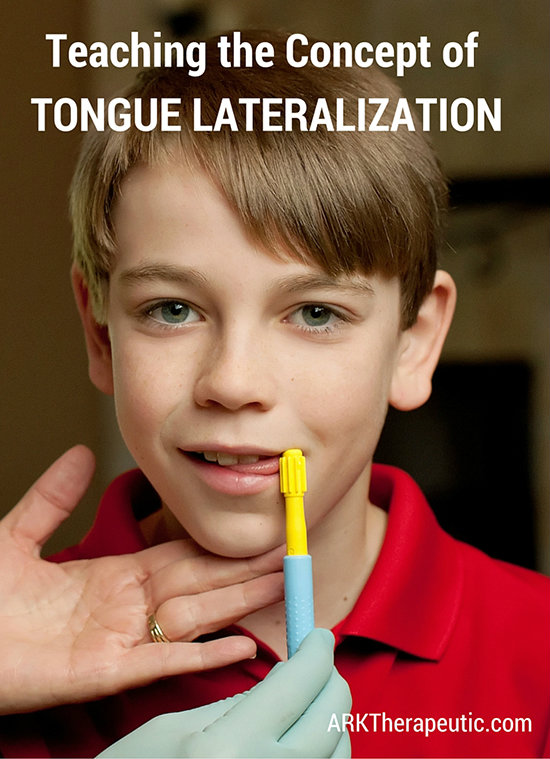Using Gross Motor for Oral Motor - How Trunk Turning Exercises Can Improve Tongue Lateralization
Posted by Debra C. Lowsky, MS, CCC-SLP on 18th Dec 2013
Tongue lateralization is the ability to move the tongue from side to side inside the mouth. It's an important skill for feeding therapy and development, as the tongue lateralizes in order to manipulate food to be chewed and formed into a ball (or bolus) before swallowing. It's also how we go "fishing" for leftover food particles in the cheeks, around the gums and teeth, and on the lips.
There are several ways you can "test" for this. Ask the child to imitate you "wagging" your tongue. Or, place ARK's Probe or Z-Vibe to the corner of the mouth on each side and prompt the child to touch it with his tongue tip (in the picture above, for example, I'm doing this with the Z-Vibe Preefer Tip). Or, place the Probe in the middle of the bottom lip and ask the child to touch it with his tongue tip. Then move the Probe in increments to the corner of the mouth, prompting him to touch it with his tongue tip at each increment (this provides a tactile cue for the tongue to follow).
.

.
Remember, one does not need to perform this oral motor task for speech sound development. Yes, the sides of the tongue need to make contact with the upper back teeth for such phonemes as r, sh, ch, etc., but no speech sounds are made with the tongue lateralizing. This movement is strictly for feeding. So observe the child eating. Really get in a position for a good view into the oral cavity. Overemphasize chewing yourself, making a "yum-yum" sound. Is the food being moved side to side? What type of food is it. Puréed? Mechanical soft? Chopped? Regular? Maybe the child isn't progressing to eat harder-to-chew foods because he cannot lateralize. It has also been my experience (as it was just this past week), that some children may only lateralize to one side. I know this is puzzling, but every now and then this happens in therapy to me. So keep an eye out for tongue lateralization to both sides.
To teach the concept of tongue lateralization, I usually start with trunk turning exercises. The idea here is to start gross motor and teach the child how to reach across the midline, physically moving their arms side to side. Once the child understands this concept of moving side to side, it's a lot easier for them to understand that concept on a smaller scale inside the mouth. In a few cases, I have observed tongue lateralization beginning to develop after we do trunk turning for three weeks (WITH the parent following through with this exercise at home - very important).
.
.
1. In the beginning, sit behind the child so you can best direct his or her movements. Have the child seated with their back to you, between your legs.
2. In the video above, we're using a classic peg board, but any number of games/objects would work. You can use a cup of cherries to eat, puzzle pieces, building blocks, etc.
3. Put the activity directly between the child's legs (so make sure the game isn't too big), and the peg pieces off to the left side by his hip. You want the pegs/pieces to be far enough to the left so that he really has to reach across his body (aka across midline) to pick them up with his right hand.
4. What I do is hold the left hand so that he can only use his right hand. Once he returns to the midline position, it's ok for him to then pass the peg/piece to the other hand.
5. Repeat about 15 times. Then repeat with pegs to his right side/hip, reaching across his body with his left hand.
6. Home practice is a must! If the parent/caretaker is not present in therapy, make a video explaining the activity and email it to them. Or send them my way to watch this one :)
.
For related activities, check out this article on oral motor exercises and this one on fun oral motor activities with food.
.
All my best,
Debbie
Debra C. Lowsky, MS, CCC-SLP
.

